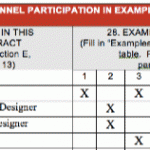
One of the most challenging things you can be tasked to do is define a firm’s marketing budget.
What’s the right marketing budget for a small architecture firm in Wayne, PA? What’s the right marketing budget for the largest construction firm in Michigan?
Try as you might to find a legitimate rule of thumb (5-13% of total revenue is a common one), there is no “apples-to-apples” comparison that answers, “how much should our firm spend on marketing?”
But there are a few rarely mentioned building blocks you should consider before finalizing your marketing budget. When talking about marketing budgets, a lot of people just assume a percentage of total revenue is the only way to come up with a legitimate number.
But that’s not true.
In fact, there are some people who say, with a few building blocks, you can “math” your way to a multi-million-dollar business.
I’m going to explain how to do that. But first, let’s talk about some of those metrics and how they relate to your marketing budget.
Customer Acquisition Cost
The customer acquisition cost is how much it costs you to gain a new client. One way to get this number is to add up everything you spent to obtain new clients over the last five years. Then divide that by the number of new clients you gained in the last 5 years.
For the sake of this discussion, let’s say you determine that your cost of acquisition is $15,000 per client. With this information, you can surmise that it will cost you $75,000 to gain five new clients this year.
With this information alone, you can come up with a very simple budget number. Let’s say you spend $20,000 a year maintaining your current clients and want to add five new clients. Your budget would be $95,000.
But it gets even more interesting with the next few metrics.
Average Assignment Value
Average assignment value is pretty self-explanatory. What’s your average fee per assignment? An assignment can be a task order, contract, purchase, or project…whatever. Just be consistent with what you track.
Profit
Profit is simply what you make on an assignment after your costs. Another way to calculate it is the percent profit your firm records at the end of each year.
For this discussion, let’s say your average assignment value is $100,000 and your profit is 10%.
Here is where you can easily get tripped up.
“I’m making $10,000 in profit, but it costs me $15,000 to acquire that client? I’m losing money!”
Not necessarily. That’s where this next metric comes into play.
Average Customer Lifetime Value
The average customer lifetime value is the total fees you receive from the average client over the life of that relationship.
Let’s say the average lifetime value of your clients is $1M. Since your profit is 10%, you would earn a profit of $100,000 from each client.
In this scenario, your customer acquisition cost is just 1.5% of the profit you receive from each client.
So, you are actually not losing money when your customer acquisition cost is $15,000. In fact, you can spend far more than that and still turn a profit.
But The Numbers Might Be Even Better
Depending on your firm’s procedures, they might calculate profit after marketing expenses are already accounted for. So that cost of customer acquisition appears in the cost side of the equation, not the profit side.
In the scenario we discussed above, you could theoretically spend $15,000 to acquire a new client, do the first assignment for free, and still break even.
Customer Retention Costs
Just keep in mind that you should also consider customer retention costs, which are very common in service businesses.
“Math” Your Way To A Multi-Million-Dollar Business
Let’s say your average client relationship is five years. You would earn an average of $200,000 per year from each client (two assignments).
How would you get to a five million dollar per year business?
$200,000 x 25 clients = $5,000,000
Therefore, you would need 25 clients (and 50 assignments) per year to be at $5M.
Building Blocks To A Better Marketing Budget
Rules of thumb give you a general idea of the appropriate range for your marketing budget. And maybe that’s good enough. But with some historical information and a few building blocks, you can create a better marketing budget.
Let’s calculate a quick marketing budget, using the example above, to build a $5M/year business into a $7M/year business.
Let’s say your conservative estimate of revenues you expect from existing clients is $2M. You’ll need to generate $5M from new clients.
Remember from our example, you need 25 clients per year to generate $5M. We also know that our customer acquisition cost is $15,000.
25 x $15,000 = $375,000
Now, tag on your customer retention costs. Let’s say you did your research and figured out those are about $50,000 per year.
$375,000 + $50,000 = $425,000
Your total marketing budget is $425,000.
As a percentage, that’s 8.5% of last year’s $5M revenue. So, it’s in that 5-13% range (which is a good sanity check).
Using building blocks and historical data gives the advantage of being able to justify the logic of how you got to your marketing budget number.
Now It’s Your Turn
What have you found helpful when developing a marketing budget? Leave your response in the comments and help others build a better marketing budget.





[…] Drip has a variety of sophisticated integrations that automatically track which of my students bought what, when, and for how much. It will also automatically calculate each student’s lifetime value (which I discussed in my post on marketing budgets). […]